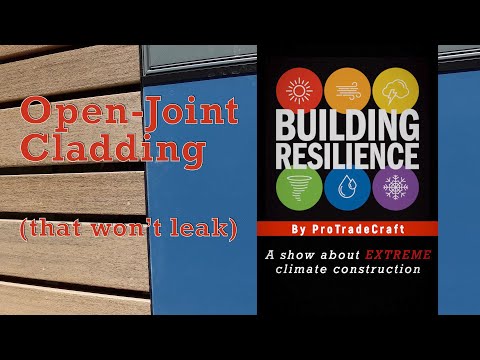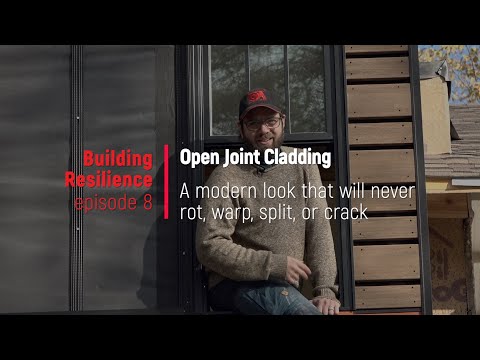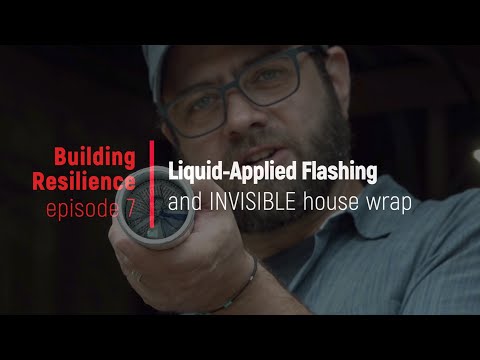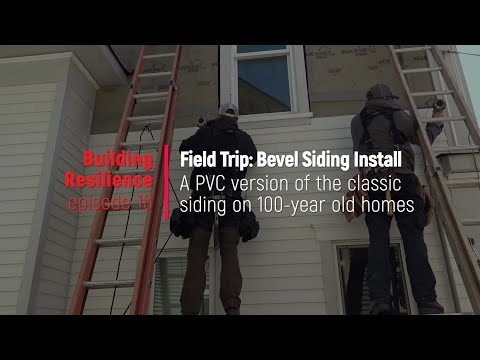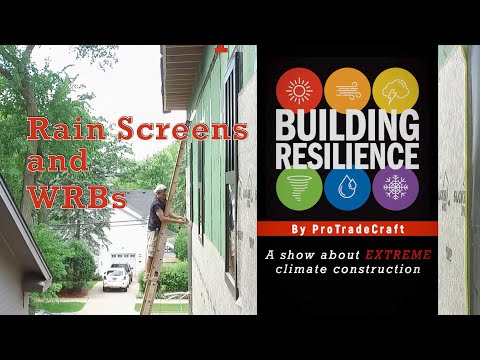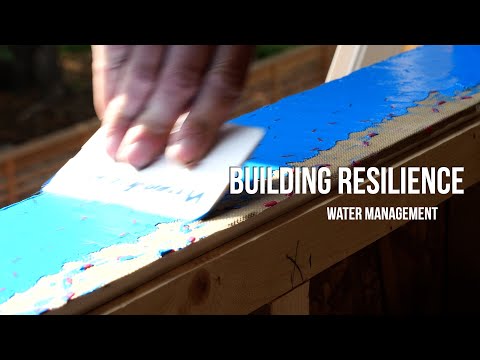Well, the leaves are turning, there’s frost on the pumpkins, and there’s some really cool frost on the AZEK PVC sheets that we’re going to install in this episode of Building Resilience.
Last time, you’ll remember, we were buttoning up the outside of the structure with WRBs and rain screen systems from Benjamin Obdyke.
“If you want to get me fired up and get me super excited, bring me whatever Benjamin Obdyke has been working on in their secret lab. These guys consistently come out with some of the coolest stuff for high-performance building.”
Rainscreens and WRBs protect the structure from water damage
Maybe the coolest thing we test drove was the self-adhering HydroGap-SA: A peel and stick housewrap. Over that, we put up SlickerMax rainscreen to allow drainage and drying.
On the top section of the house, we used Invisiwrap UV as the weather barrier because that section gets an open cladding system from AZEK, which needs something durable and black behind it. The rainscreen is created by battens that do not compress and allow sideways air movement.
We’re going to work our way up to that open cladding in the next episode because today, we’re starting at ground level with AZEK sheets and trim with PaintPro technology.
Before we cover the walls with board and battens...
before we even put up the rainscreen from the last episode, in fact...
We need to address the base of the wall where there were formerly water problems.
Small details can cause big water problems like rot and decay
The foundation is poorly executed and, quite frankly, kind of screwed up.
"So whoever built this well, they screwed up."
See?
"And so when you find funky things, you get to rename them. So right over here, we’re going to call this our tread-supporter-ledge detail.
And this here, we’re going to call this our scupper-trough-water-catcher-keeper-panel-destroyer. You can see it’s forced all the water back into this panel and the framing.
And notice that the foundation is extending proud of the structure.
So originally—intentionally—the foundation was proud. But notice they had the good sense to pitch this. This builder from 15 years ago did not have the good sense to pitch it.
And not only that, they could have come back and saw-cut this edge, put a bevel on it, something. But instead, not only did they leave it flat, but you can see this lip here is creating a nice reservoir-catchment condition that’s letting the water hit right back at the framing and pretty significant deterioration here.
Way to go, fiber-cement."
So yeah, they really screwed up by channeling all of the rain into the wall.
PVC sheets are great for wrapping foundations because they're rated for ground contact
OA decided to build out the base of the wall to mimic the built-out base of the stucco sections, with their signature modern flair.
AZEK sheets are buried in the ground, shimmed straight, and then capped with heavy-gauge metal drip edge flashing, which is being fit by Chris.
Around the corner, Sol and Stephen are leveling the last AZEK sheets and shimming them straight. Chris nails his drip edge in place, and it’s time to put up the corner trims that border the AZEK sheets.
There are outside corners, inside corners, and horizontal channels between the sheets.
This is where the top of the trim band will go, which is being cut right this minute and shaped to butt into the stucco.
The boards are cut to fit tightly, so it needs to be bent out to slip into the channel of the Tamlyn trim.
They’re cut to fit tightly to control shrinkage, which creates the most common installation error and misconception about working with PVC trim.
You can control PVC shrinkage with gaps, glue, and fasteners
We got a description of how that works from Dave Parker, a technical expert with AZEK.
It’s typically not expansion and contraction that people have a bad experience with PVC.
"It’s typically, and all plastics do this—but what happens is after they get up to a hot temperature one time and then they cool back down, and if that happens two or three times, what happens there’s a phenomenon called annealing that takes place with plastics.
So the denser the material, the more movement you’re going to get naturally. Because you’ve got that much more resins in there to absorb that heat, and it’s going to move a lot more.
If we can constrict that PVC so when it goes through that hot to cold cycle, it anneals, and we’re constricting it and holding it in place, we essentially eliminate that annealing.
Because after it does it one time, it doesn’t do it again. So when you get into thicker material like PVC trim in the 4-quarter 5-quarter thickness products, the trick is installation.
And installation plays a key role in limiting the amount of expansion-contraction that you’re going to see.
So the first thing that you do is always fasten the PVC correctly and make sure you’ve got the right number of fasteners in it.
And the second thing is, what we want to do is all of our butt ends or anywhere where we’re butting PVC to PVC; we want to glue those joints."
And before doing that, you have to open the bottle. We’re going to go deeper into preassembling trim later because we are still installing the first piece of trim. These are plugs made from the PaintPro material, so the painters could perfectly match the trim.
Above the bottom trim band is another metal trim, this one shaped like a z-flashing, but it’s not flashing. It’s an architectural element. The wall was already watertight before they installed the SlickerMax.
PVC PaintPro Panels are the base of the AZEK board and batten system
Now we’re ready for full sheets. They’ll begin at the outside corner and work toward the stucco section. So this sheet needs to be cut around the window.
Sol and Stephen work together to transfer measurements and mark the cutouts. First, they cut the sheet to length. Sheets should not bridge floors and should break at the subfloor level.
Next, Sol marks out the window. He’s kind of legendary for his expertise in cutting sheets to fit strange shapes on the first try.
When he’s sure he’s got his lines in the right place, he reaches for his saw and gets after cutting that sheet. Do you think it’s going to fit? Of course, it fits. And he screws the first sheet in place.
One thing about cutting PVC trim and sheet stock is all the static cling of the sawdust or whatever you call it.
Do you think his scribble list is gonna blow away?
Yup.
Anyway, static remover spray does a great job of keeping that dust from sticking to you or your tools.
You can fasten PVC trim with exterior trim screws or siding nails
On the first wall, the guys used screws to attach the sheets to the wall, but because there is a drainage mesh rainscreen material behind the sheets, the screws pull the sheets in and compress the rainscreen.
It’s okay with Cortex screws because the double threading allows you to back them out slightly and perfectly align the sheets, so they switched to using a coil nailer with ring-shank siding nails.
After all, the sheets are only fastened along the edges where battens will go later. So as long as the nails are within an inch of the edge, they’ll be covered.
Panels are gapped about an ⅛ inch for movement, and with any luck, that gap is where the batten screws will land.
Up on the top section, where the rainscreen is incompressible plastic battens, they use screws again.
Glue scarf joints with AZEK PVC cement to control movement
And because this is a long piece, they’ll need to join two pieces together with a scarf joint.
"How’s it look?"
"Okay, yeah, it fits. How are you doing there?"
"I’m tight."
"Alright. Well, I need to glue it."
Glue Fairy: "Did someone say glue?"
And just like that, the glue fairy shows up.
"Good thing you called."
Oh. It’s Steve Bloom with AZEK.
"We’ve got our brand new AZEK cellular PVC cement blue applicator, which would be perfect for this job.
And I see from looking at this, you've got a perfect scarf joint going, which is the best application.
All you need now is a thin bead of adhesive from AZEK, and two fasteners on each side of your scarf joint, and that joint will not open up."
And that’s the balance of the AZEK sheets and trim stock going up today. Now they’ll preassemble the window and door trim, install them on the wall, and then put up the battens.
He fastens the top and bottom to make sure the batten will be plumb and straight. Then he screws off the center section.
They generally snap a line for tall battens to make sure to keep them straight. And then they get after it because the sun is sinking fast.
Batten placement
Battens are placed over every seam and then between the seams every 16-inches into studs. This is why there are no fasteners needed in the field of the panels when they are initially installed—because the battens will be placed every 16 inches and screwed vertically every 12 inches.
With this wall just about complete, it’s time to put the kids to work filling the screw holes with PaintPro plugs.
But don’t worry, he’s not carrying any lumber with that broken arm. Or climbing ladders.
We’re going to do that next time when we install AZEK’s open cladding, take a closer look at how the system works, and then we’ll test it all out with a watering can.
Next time on Building Resilience.
—Building Resilience is a production of the SGC Horizon media network. See all of season two here.
